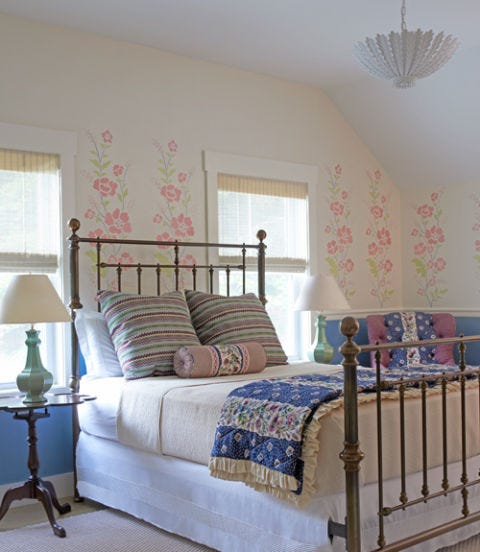Make Your Own Graffiti Stencil

Monica Buck
Dean Barger—a decorative painter with studios in both Manhattan and Northeast Harbor, Maine—has been creating beautiful interiors for over 20 years. For the last eight years, Dean has also worked as an instructor of decorative art and mural painting, sharing his skills with his students at the New York School of Interior Design. Most recently, he displayed his handiwork with a floral-and-vine stencil treatment on the master bedroom walls of the 2014 Country Living House of the Year in Rhinebeck, New York (pictured). Read on, for Dean's crash-course in decorative painting.
Tip 1: Start with a simple design.
"Look for circles or bubbles, a simplified bird shape or flowers—it's best to start with something simple and go from there," Dean explains. Rather than tackling an entire wall, Dean also advises you take on a more beginner-friendly project, like stenciling a chair rail around a powder room.
Tip 2: Invest in quality tools. (And take good care of them.)
"It's important to buy nice tools," says Dean. "Buy the better tape, the better brush. It's worth it, and it will show up in your work." Dean recommends tracing your stencil on Mylar, a transparent plastic paper. From there, place the stencil on a self-healing cutting board and use an X-Acto knife to cut out the windows of your stencil. "I really advise people to change their knife blades often," says Dean. "This will give the stencil a clean, crisp line."
Here's an idea of what you'll need in your toolkit:
• Stencil of choice
• Stencil brush (look for something round and stout)
• Quality painters tape
• Pencils
• Paint
• Paper towels
• Level
• Mylar
• Self-healing cutting board
• Japanese screw punch
• Sharpie pens
Tip 3: Do the prep work.
Since a surface with a slight sheen is most forgivable (it allows you to quickly wipe away any mistakes), Dean recommends beginners consider repainting flat walls if necessary, before starting your stenciling work.
Tip 4: Practice. Practice. Practice.
Practice using your stencil on a disposable surface before you begin painting (a cardboard box will do). As Dean explains, "We try to work out any problems and challenges before we even begin a project so that when we're on the ladder we can just work."
Tip 5: Less is more.
To ensure your paint doesn't seep under the edges of your stencil, don't overload your brush with paint. A light dusting of a spray-on adhesive like Krylon Easy Tack will help secure your stencil and further prevent your paint from creeping.
Bonus! Put Dean's tips to good use with this printable stencil templateinspired by his large-scale decorative treatment seen in the master bedroom of our 2014 House of the Year.
RELATED:
Tour the 2014 House of the Year
8 Paint Techniques that Will Transform Your Home
101 Bedroom Design Ideas You'll Love
Laurren Welch Laurren Welch is a freelance editor, writer, and creative who covers lifestyle, interiors, entertaining, fashion, and more.
This content is created and maintained by a third party, and imported onto this page to help users provide their email addresses. You may be able to find more information about this and similar content at piano.io
Make Your Own Graffiti Stencil
Source: https://www.countryliving.com/diy-crafts/how-to/a5712/wall-stenciling-tips/
Posted by: rodriguezwiterestich.blogspot.com

0 Response to "Make Your Own Graffiti Stencil"
Post a Comment